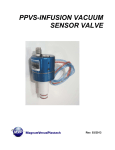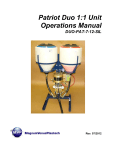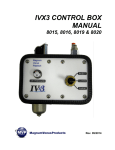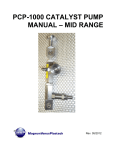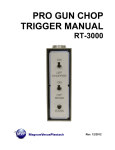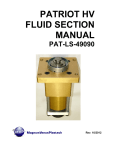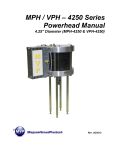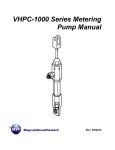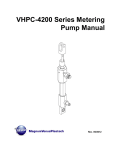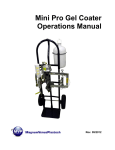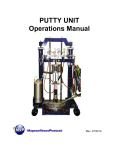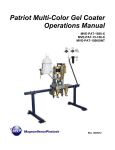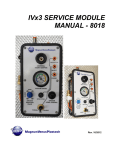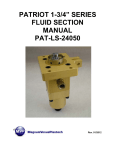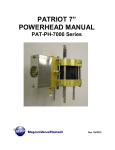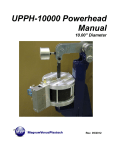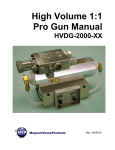Download ivx3 injection valve 8010
Transcript
IVX3 INJECTION VALVE 8010 Rev. 03/2012 IVx3 Injection Valve Manual CORPORATE HEADQUARTERS and MANUFACTURING th 11692 56 Court * Clearwater, FL 33760 * Tel 727-573-2955 * Fax 727-571-3636 TECHNOLOGY CENTER and WEST COAST MANUFACTURING 1862 Ives Ave. * Kent, WA 98032 * Tel 253-854-2660 * Fax 253-854-1666 MVP PLASTECH UK Chilsworthy Beam, Gunnislake, Cornwall, PL18 9AT UK, * Tel:+44 (0) 1822 832621 Fax: +44 (0) 1822 833999 www.mvpind.com Rev. 03/2012 Page | 2 IVx3 Injection Valve Manual TABLE OF CONTENTS: SECTION: Page TERMS & CONDITIONS OF SALE 4 SAFETY & WARNING INFORMATION 6 INTRODUCTION 15 OVERVIEW 16 IVX3 INJECTION VALVE CONNECTIONS 17 OPERATING PROCEDURES 19 FLUID VALVE REPAIR 20 ACTUATOR REPAIR 26 TESTING 29 PARTS DRAWINGS 34 REVISION INFORMATION 41 Rev. 03/2012 Page | 3 IVx3 Injection Valve Manual Terms & Conditions of Sale: Customs duties, import and export licenses and certificates, if required, and all local taxes are excluded from this offer. If US state and local taxes are applicable and not included in equipment invoice, such amount may be invoiced later. Delivery dates or shipping schedules are approximate and based upon the most recent information available at the time of order. Dates may be adjusted upon receipt of subsequent information or modification of order. Seller will ship prior to the delivery date if possible, but not without Buyer’s consent on Advanced Equipment sales. All contract dates and timelines begin upon receipt at MVP of customer purchase order, signed Terms and Conditions of Sale (if applicable), and down payment per quotation (if applicable). If shipments are delayed by the Buyer, or because the Buyer’s account is in arrears, payments shall become due on the date when the Seller is prepared to make shipment. Products held by the Seller for the Buyer shall be at the risk and expense of the Buyer. Damages, defects or shortages must be communicated immediately to MVP. Discrepancy in pricing and/or quantities on invoices must be reported within 30 days of the invoice date. Claims made 30 days or more following the invoice date will not be honored. Permission to return items must be requested and granted in advance. No credit will be given if items are returned prior to requesting and receiving permission. All returns are subject to a restocking fee. The standard 15% charges may be increased or decreased depending on the reason for the return. Special ordered items may not be returned. Seller warrants that the mechanical operation of the goods as specified shall be free from faults in respect to materials and workmanship for a period of 12 months for parts from the date of invoice. For systems, 12 months from start-up or, if earlier, 18 months from the date of the Bills of Lading. The warranty does not cover general wear and tear or damage due to negligence or improper use. Seller’s liability under the warranty shall be limited solely to repair or replacement costs, and has no responsibility for reimbursing repair cost incurred by Buyer in connection with equipment without first giving written authorization for such charges. Seller makes no express warranties except those set forth in this agreement, and disclaims all other warranties, expressed or implied, including without limitation, implied warranties of non-infringement merchantability and fitness for a particular purpose. Seller accepts no liability for loss of production, loss of profits, or other direct or indirect damages. In any claim by the Buyer Rev. 03/2012 Page | 4 IVx3 Injection Valve Manual against the Seller in respect of the goods, the liability of the Seller shall be limited to the value of the goods. Many factors beyond Seller’s control contribute to the success of Buyer’s finished products, such as raw materials used to manufacture the product. Equipment is warranted to perform to specifications detailed in quotation, but Seller is not liable for quality or quantity of finished products produced by Buyer. The country of origin is the United States of America. Sale, installation and all rights of the parties are governed by the laws of the state of Florida. Venue with regard to any litigation shall be in Pinellas County, Florida. The parties agree to waive all rights to trial by jury as to any and all disputes. The goods remain the property of the Seller until full payment is received. Sale of equipment is subject to application and issuance of proper US Government export license and regulations, if applicable. Installation of equipment is responsibility of Buyer and Seller, with cost responsibility and number of days provided as detailed in original customer Quotation. Seller will provide installation supervision personnel within 30 days of customer request. If installation is delayed by the Buyer more than six months from the date of shipment, or if customer facility or material/parts are not prepared for installation, seller will invoice full installation costs, up to $1,250 a day plus expenses, for each MVP installation technician on site. Seller has the option to waive this fee at its discretion. Parties shall be excused for delays caused by embargoes, acts of civil or military authorities, Acts of God, or other circumstances beyond the reasonable control of the parties. Notification of such delays must be made in writing within ten days of occurrence. Our agreement supersedes any previous agreement and applies in full. Rev. 03/2012 Page | 5 IVx3 Injection Valve Manual SAFETY & WARNING INFORMATION: OPERATING YOUR POLYESTER SYSTEM SAFELY 1. Introduction Any tool, if used improperly, can be dangerous. Safety is ultimately the responsibility of those using the tool. In like manner, safe operation of polyester processes is the responsibility of those who use such processes and those who operate the equipment. This manual outlines procedures to be followed in conducting polyester operations safety. This system has been specifically designed for use of Polyester Resin, Gel-Coat, and Methyl Ethyl Ketone Peroxides (MEKP) applications. Other formulations or blends considered for use in this equipment is strictly prohibited without the expressed consent by Magnum Venus Plastech Inc. Magnum Venus Plastech cannot eliminate every danger nor foresee every circumstance that might cause an injury during equipment operation. Some risks, such as the high pressure liquid stream that exits the spray tip, are inherent to the nature of the machine operation and are necessary to the process in order to manufacture the end-product. For this reason, ALL personnel involved in polyester operations should read and understand the Safety Manual. It is very important for the safety of employees involved in the operation that equipment operators, maintenance and supervisory personnel understand the requirements for safe operation. Each user should examine his own operation, develop his own safety program and be assured that his equipment operators follow correct procedures. Magnum Venus Plastech hopes that this manual is helpful to the user and recommends that the precautions in this manual be included in any such program. Magnum Venus Plastech recommends this Safety Manual remain on your equipment at all times for your personnel safety. In addition to the manual, Magnum Venus Plastech recommends that the user consult the regulations established under the Occupational Safety & Health Act (OSHA), particularly the following sections: 1910.94 Pertaining to Ventilation. 1910.106 Pertaining to flammable liquids 1910.107 Pertaining to spray finishing operations, particularly Paragraph (m) Organic Peroxides and Dual Component Coatings. Other standards and recognized authorities to consult are the National Fire Protection Association (NFPA) bulletins as follows: NFPA No.33 Chapter 14, Organic Peroxides and Dual Component Materials NFPA No.63 Dust Explosion Prevention NFPA No.70 National Electrical Code NFPA No.77 Static Electricity NFPA No.91 Blower and Exhaust System NFPA No.654 Plastics Industry Dust Hazards Type of Fire Extinguishing equipment recommended: Fire Extinguisher – code ABC, rating number 4a60bc. Rev. 03/2012 Page | 6 IVx3 Injection Valve Manual Extinguishing Media – Foam, Carbon Dioxide, Dry Chemical, Water Fog. Copies of the above bulletins are available, at a nominal charge from: National Fire Protection Association 470 Atlantic Avenue Boston, MA 02210 Research Report No.11 of the American Insurance Association deal with “Fire, Explosion and Health Hazards of Organic Peroxides”. It is published by: American Insurance Association 85 John Street New York, NY 10038 Local codes and authorities also have standards to be followed in the operation of your spraying equipment. Your insurance carrier will be helpful in answering questions that arise in your development of safe procedures. 1.2 Personal Safety Equipment Magnum Venus Plastech recommends the following Personal Safety Equipment for conducting safe operations of the Polyester Systems: Magnum Venus Plastech recommends that the user consult the state and local regulations established for all Safety equipment listed. 2.0 Material Safety 2.1 Hazards Associated with Laminating Operations The major hazards which should be guarded against in polyester laminating operations are those associated with: 1. The flammability and explosion dangers of the catalyst normally used – Methyl Ethyl Ketone Peroxide (MEKP). 2. The flammability dangers of clean-up solvents sometimes used (Magnum Venus Plastech recommends that clean-up solvents be non-flammable), and of resin diluents used, such as styrene. 3. The flammability dangers of catalyst diluents, if used. (Magnum Venus Plastech recommends that catalyst not be diluted. 4. The flammability dangers of the uncured liquid resins used. 5. The combustibility dangers of the cured laminate, accumulations of over spray, and laminate sandings. 6. The toxicity dangers of all the chemicals used in laminating operations with respect to ingestion, inhalation and skin and eye hazards. Rev. 03/2012 Page | 7 IVx3 Injection Valve Manual 2.2 Catalyst (Methyl Ethyl Ketone Peroxide) MEKP is among the more hazardous materials found in commercial channels. The safe handling of the “unstable (reactive)” chemicals presents a definite challenge to the plastics industry. The highly reactive property which makes MEKP valuable to the plastics industry in producing the curing reaction of polyester resins also produces the hazards which require great care and caution in its storage, transportation, handling, processing and disposal. MEKP is a single chemical. Various polymeric forms may exist which are more or less hazardous with respect to each other. These differences may arise not only from different molecular structures (all are, nevertheless, called “MEKP”) and from possible trace impurities left from the manufacture of the chemicals, but may also arise by contamination of MEKP with other materials in its storage or use. Even a small amount of contamination with acetone, for instance, may produce an extremely shock-sensitive and explosive compound. Contamination with promoters or materials containing promoters, such as laminate sandings, or with any readily oxidizing material, such as brass or iron, will cause exothermic “redox” reactions which can become explosive in nature. Heat applied to MEKP, or heat build-up from contamination reactions can cause it to reach what is called its Self-Accelerating Decomposition Temperature (SADT). Researchers have reported measuring pressure rates-of-rise well in excess of 100,000 psi per second when certain MEKP’s reach their SADT. (For comparison, the highest pressure rate-ofrise listed in NFPA Bulletin NO.68, “Explosion Venting”, is 12,000 psi per second for an explosion of 12% acetylene and air. The maximum value listed for a hydrogen explosion is 10,000 psi per second. Some forms of MEKP, if allowed to reach their SADT, will burst even an open topped container. This suggests that it is not possible to design a relief valve to vent this order of magnitude of pressure rate-of-rise. The user should be aware that any closed container, be it a pressure vessel, surge chamber, or pressure accumulator, could explode under certain conditions. There is no engineering substitute for care by the user in handling organic peroxide catalysts. If, at any time, the pressure relieve valve on top of the catalyst tank should vent, the area should be evacuated at once and the fire department called. The venting could be the first indication of a heat, and therefore, pressure build-up that could eventually lead to an explosion. Moreover, if a catalyst tank is sufficiently full when the pressure relief valve vents, some catalyst may spray out, which could cause eye injury. For this reason, and many others, anyone whose job puts them in an area where this vented spray might go, should always wear full eye protection even when laminating operations are not taking place. Safety in handling MEKP depends to a great extent on employee education, proper safety instructions and safe use of the chemicals and equipment. Workers should be thoroughly informed of the hazards that may result form improper handling of MEKP, especially in regards to contamination, heat, friction and impact. They should be thoroughly instructed regarding the proper action to be taken in the storage, use and disposal of MEKP and other hazardous materials used in the laminating operation. In addition, users should make every effort to: A. Store MEKP in a cool, dry place in original containers away from direct sunlight and away from other chemicals. B. Keep MEKP away from heat, sparks and open flames. C. Prevent contamination of MEKP with other materials, including polyester over spray and sandings, polymerization accelerators and promoters, brass, aluminum and non-stainless steels. Rev. 03/2012 Page | 8 IVx3 Injection Valve Manual D. Never add MEKP to anything that is hot, since explosive decomposition may result. E. Avoid contact with skin, eyes and clothing. Protective equipment should be worn at all times. During clean-up of spilled MEKP, personal safety equipment, gloves and eye protection must be worn. Fire fighting equipment should be at hand and ready. F. Avoid spillage, which can heat up to the point of self-ignition. G. Repair any leaks discovered in the catalyst system immediately, and clean up the leaked catalyst at once in accordance with the catalyst manufacturer’s instructions. H. Use only original equipment or equivalent parts from Magnum Venus Plastech in the catalyst system (i.e.: hoses, fitting, etc.) because a dangerous chemical reaction may result between substituted parts and MEKP. I. Catalyst accumulated from the purging of hoses or the measurement of fluid output deliveries should never be returned to the supply tank, such catalyst should be diluted with copious quantities of clean water and disposed of in accordance with the catalyst manufacturer’s instructions. The extent to which the user is successful in accomplishing these ends and any additional recommendations by the catalyst manufacturer determines largely the safety that will be present in his operation. 2.3 Clean-Up Solvents and Resin Diluents WARNING A hazardous situation may be present in your pressurized fluid system! Hydrocarbon Solvents can cause an explosion when used with aluminum or galvanized components in a closed (pressurized) fluid system (pump, heaters, filters, valves, spray guns, tanks, etc.). The explosion could cause serious injury, death and/or substantial property damage. Cleaning agents, coatings, paints, etc. may contain Halogenated Hydrocarbon Solvents. Some Magnum Venus Plastech spray equipment includes aluminum or galvanized components and will be affected by Halogenated Hydrocarbon Solvents. A. There are three key elements to the Halogenated Hydrocarbon (HHC) solvent hazard. a. The presence of HHC solvents. 1,1,1 – Trichloroethane and Methylene Chloride are the most common of these solvents. However, other HHC solvents are suspect if used; either as part of paint or adhesives formulation, or for clean-up flushing. b. Aluminum or Galvanized Parts. Most handling equipment contains these elements. In contact with these metals, HHC solvents could generate a corrosive reaction of a catalytic nature. b. Equipment capable of withstanding pressure. When HHC solvent contact aluminum or galvanized parts inside a closed container such as a pump, spray gun, or fluid handling system, the chemical reaction can, over time, result in a build-up of heat and pressure, which can reach explosive proportions. When all three elements are present, the result can be an extremely violent explosion. The reaction can be sustained with very little aluminum or galvanized metal; any amount of aluminum is too much. Rev. 03/2012 Page | 9 IVx3 Injection Valve Manual A. The reaction is unpredictable. Prior use of an HHC solvent without incident (corrosion or explosion) does NOT mean that such use is safe. These solvents can be dangerous alone (as a clean-up or flushing agent) or when used as a component or a coating material. There is no known inhibitor that is effective under all circumstances. Furthermore, the mixing of HHC solvents with other materials or solvents, such as MEKP, alcohol, and toluene, may render the inhibitors ineffective. B. The use of reclaimed solvents is particularly hazardous. Reclaimers may not add any inhibitors. Also, the possible presence of water in reclaimed solvents could feed the reaction. C. Anodized or other oxide coatings cannot be relied upon to prevent the explosive reaction. Such coatings can be worn, cracked, scratched, or too thin to prevent contact. There is no known way to make oxide coatings or to employ aluminum alloys, which will safely prevent the chemical reaction under all circumstances. D. Several solvent suppliers have recently begun promoting HHC solvents for use in coating systems. The increasing use of HHC solvents is increasing the risk. Because of their exemption from many State Implementation Plans as Volatile Organic Compounds (VOC’s), their low flammability hazard, and their not being classified as toxic or carcinogenic substances, HHC solvents are very desirable in many respects. WARNING: Do not use Halogenated Hydrocarbon solvents in pressurized fluid systems having aluminum or galvanized wetted parts. NOTE: Magnum Venus Plastech is aware of NO stabilizers available to prevent Halogenated Hydrocarbon solvents from reaction under all conditions with aluminum components in closed fluid system. TAKE IMMEDIATE ACTION… Halogenated Hydrocarbon solvents are dangerous when used with aluminum components in a closed fluid system. A. Consult your material supplier to determine whether your solvent or coating contains Halogenated Hydrocarbon Solvents. B. Magnum Venus Plastech recommends that you contact your solvent supplier regarding the best non-flammable clean-up solvent with the heat toxicity for your application. C. If, however, you find it necessary to use flammable solvents, they must be kept in approved, electrically grounded containers. D. Bulk solvent should be stored in a well-ventilated, separate building, 50 feet away from your main plant. E. You should allow only enough solvent for one day’s use in your laminating area. F. “NO SMOKING” signs must be posted and observed in all areas of storage or where solvents and other flammable materials are used. G. Adequate ventilation (as covered in OSHA Section 1910.94 and NFPA No.91) is important wherever solvents are stored or used, to minimize, confine and exhaust the solvent vapors. H. Solvents should be handled in accordance with OSHA Section 1910.106 and 1910.107. Rev. 03/2012 Page | 10 IVx3 Injection Valve Manual 2.4 Catalyst Diluents Magnum Venus Plastech spray-up and gel-coat systems currently produced are designed so that catalyst diluents are not required. Magnum Venus Plastech, therefore, recommends that diluents not be used. This avoids the possible contamination which could lead to an explosion due to the handling and mixing of MEKP and diluents. In addition, it eliminates any problems from the diluents being contaminated through rust particles in drums, poor quality control on the part of the diluents suppliers, or any other reason. If, however, diluents are absolutely required, contact your catalyst supplier and follow his instructions explicitly. Preferable, the supplier should premix the catalyst to prevent possible “on the job” contamination while mixing. WARNING If diluents are not used, it should be remembered that catalyst spillage, gun, hose and packing leaks are potentially more hazardous, since each drop contains a higher concentration of catalyst, and therefore will react quicker with over spray and the leak. 2.5 Cured Laminate, Overspray and Laminate Sandings Accumulation A. Remove all accumulations of overspray, FRP sandings, etc. from the building as they occur. If this waste is allowed to build up, spillage of catalyst is more likely to start a fire, in addition, the fire would burn hotter and longer. B. Floor coverings, if used, should be non-combustible. C. Spilled or leaked catalyst may cause a fire if it comes in contact with an FRP product, oversprayed chop or resin, FRP sandings or any other material with MEKP. To prevent this spillage and leakage, you should: 1. Maintain your Magnum Venus Plastech System. Check the gun several times daily for catalyst and resin packing or valve leaks. REPAIR ALL LEAKS IMMEDIATELY. 2. Never leave the gun hanging over, or lying inside the mold. A catalyst leak in this situation would certainly damage the part, possibly the mold, and may cause a fire. 3. Inspect resin and catalyst hoses daily for wear or stress at the entry and exits of the boom sections and at the hose and fittings. Replace if wear or weakness is evident or suspected. 4. Arrange the hoses and fiberglass roving guides so that the fiberglass strands DO NOT rub against any of the hoses at any point. If allowed to rub, the hose will be cut through, causing a hazardous leakage of material which could increase the danger of fire. Also, the material may spew onto personnel in the area. 2.7 Toxicity of Chemicals A. Magnum Venus Plastech recommends that you consult OSHA Sections 1910.94, 1910.106, 1910.107 and NFPA No.33, Chapter 14, and NFPA No.91. B. Contact your chemical supplier(s) and determine the toxicity of the various chemicals used as well as the best methods to prevent injury, irritation and danger to personnel. C. Also determine the best methods of first aid treatment for each chemical used in your plant. Rev. 03/2012 Page | 11 IVx3 Injection Valve Manual 2.8 Treatment of Chemical Injuries Great care should be used in handling the chemicals (resins, catalyst and solvents) used in polyester systems. Such chemicals should be treated as if they hurt your skin and eyes and as if they are poison to your body. For this reason, Magnum Venus Plastech recommends the use of protective clothing and eye wear in using polyester systems. However, users should be prepared in the event of such an injury. Precautions include: 1. Know precisely what chemicals you are using and obtain information from your chemical supplier on what to do in the event the chemical gets onto your skin or into the eyes, or is swallowed. 2. Keep this information together and easily available so that it may be used by those administering first aid or treating the injured person. 3. Be sure the information from your chemical supplier includes instructions on how to treat any toxic effects the chemicals have. WARNING Contact your doctor immediately in the event of any injury and give him the information you have collected. If your information includes first aid instructions, administer first aid immediately while you are contacting your doctor. Fast treatment of the outer skin and eyes that contact such chemicals generally includes immediate and thorough washing of the exposed skin and immediate and continuous flushing of the eyes with lots of clean water for at least 15 minutes or more. These general instructions of first aid treatment, however, may be incorrect for some chemicals; that is why you must know the chemicals and treatment before an accident occurs. Treatment for swallowing a chemical frequently depends upon the nature of the chemical. NOTE: Refer to your System User Manual for complete and detailed operating instructions and service information. Rev. 03/2012 Page | 12 IVx3 Injection Valve Manual 3.0 Equipment Safety WARNING Magnum Venus Plastech suggest that personal safety equipment such as EYE GOGGLES, GLOVES, EAR PROTECTION, and RESPIRATORS be worn when servicing or operating this equipment. Ear protection should be worn when operating a fiberglass chopper to protect against hearing loss since noise levels can be as high as 116 dB (decibels). This equipment should only be operated or serviced by technically trained personnel! WARNING Never place fingers, hands, or any body part near or directly in front of the spray gun fluid tip. The force of the liquid as it exits the spray tip can cause serious injury by shooting liquid through the skin. NEVER LOOK DIRECTLY INTO THE GUN SPRAY TIP OR POINT THE GUN AT OR NEAR ANOTHER PERSON. (TREAT THE GUN AS IF IT WERE A LOADED PISTOL.) 3.1 Emergency Stop Procedures The following steps should be followed in order to stop the machinery in an emergency situation 1. The ball valve located where the air enters the power head of the resin pump, should be moved to the “OFF” or closed position. To do this, simply rotate the lever on the ball valve 90 degrees. Doing this will cause all the system air to bleed out of the system in a matter of a few seconds, making the system incapable of operating NOTE: Step 2 is a precautionary step and should be followed whenever the above mentioned ball valve is activated to the stop mode. Failure to do so, can damage the regulators and components on reactivating to the “ON” position. 2. Turn all system regulators to the “OFF” position (counter-clockwise) position NOTE: Verify that the Catalyst relief line, located on the catalyst manifold, and the resin return line, located on the resin filter, are secured relieving catalyst and resin fluid pressure. 3. Catalyst pressure in the catalyst pump can be eliminated by rotating the ball valve on the catalyst manifold 90 degrees to the “open” or “on” position. Note: The “open” or “on” position is when the ball valve handle is parallel (in line) with the ball valve body. The “closed” or “off” position is when the ball valve handle is perpendicular (across) the ball valve body. 4. Resin pressure in the resin pump can be eliminated by rotating the ball valve on the resin filter 90 degrees to the “open” or “on” position. Place a container under the ball valve to catch any resin that is ejected out of the valve. Rev. 03/2012 Page | 13 IVx3 Injection Valve Manual 3.2 Grounding Grounding an object means providing an adequate path for the flow of the electrical charge from the object to the ground. An adequate path is one that permits charge to flow from the object fast enough that it will not accumulate to the extent that a spark can be formed. It is not possible to define exactly what will be an adequate path under all conditions since it depends on many variables. In any event, the grounding means should have the lowest possible electrical resistance. Grounding straps should be installed on all loose conductive objects in the spraying area. This includes material containers and equipment. Magnum Venus Plastech recommends grounding straps be made of AWG No.18 stranded wire as a minimum and the larger wire be used where possible. NFPA Bulletin No77 states that the electrical resistance of such a leakage path may be as low as 1 meg ohm (10 ohms) but that resistance as high as 10,000 meg ohms will produce an adequate leakage path in some cases. Whenever flammable or combustible liquids are transferred from one container to another, or from one container to the equipment, both containers or container and equipment shall be effectively bonded and grounded to dissipate static electricity. For further information, see National Fire Protection Association ( NFPA) 77, titled “Recommended Practice on Static Electrical”. Refer especially to section 7-7 titled “Spray Application of Flammable and Combustible Materials”. Check with local codes and authorities for other specific standards that might apply to your application. NEVER USE HARD MATERIALS SUCH AS WIRE, PINS, ETC., TO CLEAR A PLUGGED GUN. HARD MATERIALS CAN CAUSE PERMANENT DAMAGE. DAB WITH A BRISTLE BRUSH, BLOW BACKWARDS WITH AIR UNTIL CLEAR WHILE WEARING A PROTECTIVE EYE SHIELD. REPEAT AS MANY TIMES AS NECESSARY. DO NOT PERFORM ANY MAINTENANCE OR REPAIRS UNTIL YOU HAVE FOLLOWED THE PRECAUTIONS STATED ABOVE. IF YOU, AS AN EQUIPMENT OPERATOR OR SUPERVISOR, DO NOT FEEL THAT YOU HAVE BEEN ADEQUATELY TRAINED OR INSTRUCTED AND THAT YOU LACK THE TECHNICAL KNOWLEDGE TO OPERATE OR PERFORM MAINTENANCE ON A PIECE OF MAGNUM VENUS PLASTECH EQUIPMENT, PLEASE CALL MAGNUM VENUS PLASTECH BEFORE OPERATING OR PERFORMING MAINTENANCE ON THE EQUIPMENT. IF YOU HAVE ANY QUESTIONS REGARDING THE ABOVE PRECAUTIONS OR ANY SERVICE OR OPERATION PRECEDURES, CALL YOUR MAGNUM VENUS PLASTECH DISTRIBUTOR OR MAGNUM VENUS PLASTECH. NOTICE: All statements, information and data given herein are believed to be accurate and reliable but are presented without guaranty, warranty or responsibility of any kind express or implied. The user should not assume that all safety measures are indicated or that other measures are not required. DANGER: Contaminated catalyst may cause Fire or Explosion. Before working on the catalyst pump or catalyst accumulator, wash hands and tools thoroughly. Be sure work area is free of dirt, grease or resin. Clean catalyst system components with clean water only. DANGER: Eye, skin and respiration hazard. The Catalyst, MEKP, may cause blindness, skin irritation or breathing difficulty. Keep hands away from face. Keep food and drink away from work area. WARNING: Please refer to your catalyst manufacturer’s safety information regarding the safe handling and storage of catalyst. Wear appropriate safety equipment as recommended. Rev. 03/2012 Page | 14 IVx3 Injection Valve Manual Introduction: The IVX3 was designed specifically as part of the Flex Molding process to streamline the infusion process by reducing the number of valves needed. The IVX3 is a pneumatically activated three position valve – Inject, Off and Purge. The IVX3 is compatible with the MVP universal mold insert and suitable for use in other closed mold applications such as RTM Light. When used in conjunction with the PPVS vacuum control valve the IVX3 can automate the infusion process whether used with a single resin channel or multiple resin channel configuration. NOTE: It is important to have the correct parts drawing for the item you are working on. This will assist in identifying the correct part numbers for the assembly being rebuilt. The reassembly will require the use of removable Loctite® or equivalent thread lock compound. Use Super O Lube (SUPERLUBE) or MOLYKOTE 111 grease for the actuator O-rings. Use Red Grease (6706-2-1 1oz) or Magnum Gun Lube (GL-200 2oz) for the Fluid Valve. NOTE: Before starting any service work, release fluid and air pressure from system. NOTE: The IVX3 valve is closed in its non-actuated position and therefore can trap pressure not exhausted from the fluid ports. Take care when removing lines connected to the ports or when actuating the valve. Please read the manual carefully. Follow the steps in the order given, otherwise you may damage the equipment or injure yourself. During Disassembly . . . As you disassemble the equipment, lay out the components in the correct order and direction, and have all component drawings available to refer to prior to disassembly. Rev. 03/2012 Page | 15 IVx3 Injection Valve Manual Overview: Purge signal port Inject signal port Purge Outlet Hose Resin / Purge Input Hose with QD connector Fluid Valve assembly Universal Insert / Injection Port IVX3 Valve Mode Overview: OFF Mode – this is the default mode – the injection, purge and input ports are blocked. Closed - no fluid can move through the valve. Injection Mode – by applying an air signal to the Injection signal port the valve will open allowing material into the mold through the Universal insert port. Purge Mode – by applying an air signal to the Purge signal port the valve will allow resin or solvent through to the Purge port. Rev. 03/2012 Page | 16 IVx3 Injection Valve Manual Connections: Stand-Alone Injection Valve – When used as a stand-alone injection valve it, can be remotely controlled. To put the IVX3 into Injection mode send a constant 6 bar (90psi) air signal to the Injection Signal port. Remove the air signal and the valve will return to the Off mode. To put the IVX3 into Purge mode send a constant 6 bar (90psi) air signal to the Purge signal port. Again remove the air signal and the valve will return to the Off mode. Purge signal port Inject signal port Resin / Solvent Outlet Resin / Solvent Inlet Resin Injection Port Valve Pressure Ratings: Actuator air pressure: 6 bar (87 PSI) – 7 bar (102 PSI). Maximum fluid pressure (resin ports): 7 bar (102 PSI). NOTE: Use clean filtered non-lubricated air to supply the signal ports of the actuator. Rev. 03/2012 Page | 17 IVx3 Injection Valve Manual IVX3 with PPVS-INFUSION Valve – connecting the IVX3 Injection valve to the PPVSINFUSION will allow for automatic Open / Close control of the IVX3 valve based on the vacuum level. Connect the output signal of the PPVS to the Inject Signal port on the IVX3 valve. Connect the Purge Signal port to a purge valve or flush signal. The control circuit must ensure that the Inject Signal and Purge Signal ports CANNOT be pressurized at the same time, as this could cause damage to the mold, valve and/or part. Connect the Resin supply Inlet and Outlet as noted above. The PPVS-INFUSION should normally be positioned around 80mm from the IVX3 Injection valve; however this may vary depending on the application. Control boxes are available for this configuration; please contact MVP for further information. NOTE: For some applications, particularly where high flow rates are required, great care must be taken when closing a valve while an injection is in progress. The user must ensure that safe-guards are in place to prevent the sudden restriction in the supply line, due to a closed valve, from over-pressurizing and bursting it. Connect the outlet signal of the PPVS-INFUSION to the Injection port of the IVX3 valve Connect the outlet signal of the PPVS-INFUSION to the Injection port of the IVX3 valve PPVS-INFUSION PPVS-INFUSION Rev. 03/2012 Page | 18 IVx3 Injection Valve Manual Operating Procedures: NOTE: Apply release agent to the internal 10mm bore of the valve (inside the nose) when the valve is actuated in the inject position (shaft up-most) to prevent the seal sticking up. Operating Procedures using PPVS: 1. Put the IVX3 Valve in the Off mode (CLOSED). 2. Set MPG pressure and pump pressure. Caution: Do not exceed the Pressure Rating of the injection hose for the MPG or Pump pressure. Note the ratio of the pump powerhead to fluid section in this calculation. 3. Put the IVX3 Valve in Purge mode (PURGE). 4. Start machine and wait for the resin to start to flow into the supply line, prime valve, resin flows into flush line. 5. Now put the IVX3 Valve in the Off mode (CLOSED). Reset the counter before injecting into the mould for an accurate count. 6. When you are ready to Inject put the IVX3 Valve in Inject mode (Inject position). The PPVS should open and close the IVX3 valve automatically and when the valve is closed the machine should stop on the MPG. 7. When the mould is full, put the IVX3 Valve in the Off mode (CLOSED) and stop the machine. 8. Put the IVX3 Valve in Purge mode (PURGE) and then flush. Leave the IVX3 Valve in the Purge mode (PURGE) unit the material is gelled. NOTE: Leave IVX3 valve in purge mode (with air on the actuator) while the resin cures, this stops resin curing in the valve. NOTE: If the valve seal sticks in the purge position after an injection, just supply air to the inject position airline to driver the actuator upwards. Then operate the valve between purge and inject positions a number of times and ensure inside of nose is clean and the valve moves freely. Rev. 03/2012 Page | 19 IVx3 Injection Valve Manual Fluid Valve Repair: NOTE: It is important to have the correct parts drawing for the item you are working on. This will assist in identifying the correct part numbers for the assembly being rebuilt. IVX3 Spares Kit (8011) IVX3 Tool Kit (8012) Flat Tip Screw Driver for 7057 Flat Tip Screw Driver for 7055 Red Grease (6706-2-1 1oz) The IVX3 Tool Kit (8012) comprises of two specialized tools, IVX3 Tool A and IVX3 Tool B. These tools are required for the correct maintenance of the valve. Spanner for shaft flats Use band to keep tools together for storage. Screwdriver for actuator bushes Tool B Tool A Ring spanner for cylinder cap Hard Wearing Seal Quick Change: 1. Apply air to the actuator to move the valve to the Inject position. 2. Remove the two (2) Machine Screws (7057) from the bottom of the valve. 3. Carefully remove the Lower Valve Body (6986) from the Upper Valve Body (6985). Rev. 03/2012 Page | 20 IVx3 Injection Valve Manual 4. Re-attach the Lower Valve Body (6986) to the Upper Valve Body (6985) using one of the Machine Screws (7057). Position the Lower Valve Body as shown below and tighten the screw. 5. Apply air to the actuator to move the valve to the Purge position and fully expose the seal as shown below. 6. Use IVX3 Tool A or B on the flats of the Seal Upper Insert (6978) to stop it turning as you unscrew the Slotted Screw (7055) from the end of the Lower Insert (6979). 7. Remove the Seal – Hard Wearing (7052) from the Seal Upper Insert (6978) and press out the Seal Lower Insert (6979) using the Machine Screw (7057). 8. Replace the O-Ring (6988) on the Seal Upper Insert (6978) and Seal Lower Insert (6979) applying Red Grease (6706-2-1 1oz) to both. 9. Install the new Seal - Hard Wearing (7051) onto the Upper Insert (6978) and install the Lower Insert (6979) into the end of the new Seal - Hard Wearing. 10. Apply a drop of removable thread lock compound to the end of the Slotted Screw (7055) and thread it into the end of the Seal Upper Insert (6978). Use IVX3 Tool A or B on the flats of the Seal Upper Insert to stop it turning as you tighten the Slotted Screw. Rev. 03/2012 Page | 21 IVx3 Injection Valve Manual Note: It is important to follow the following steps carefully to ensure the seal is not damaged during the installation process. 11. Apply Red Grease (6706-2-1 1oz) to the Seal – Hard Wearing (7052) to ensure that it is well lubricated. 12. Put the Valve into the Off mode by removing the air signal from the upper port. This will pull the new seal partially back into the Upper Valve Body (6985). 13. Remove the Lower Valve Body (6986) positioned to assist the maintenance process by unscrewing the single Machine Screw (7057). 14. Carefully reinstall the Lower Valve Body (6986) over the Upper Valve Body (6985); press firmly over the Seal – Hard Wearing (7052). 15. Install the two Machine Screws (7057) through both Valve Bodies and tighten into the Actuator Cylinder (6981). 16. Actuate the valve to the Purge position and then to the Off position. 17. Actuate the valve the Inject position and then to the Off position. 18. Repeat steps 16 & 17 a number of times to correctly seat the seal and check for correct valve operation. Note: Allow proper drying time for the thread lock compound before using the valve assembly. Rev. 03/2012 Page | 22 IVx3 Injection Valve Manual Disassembly: 1. Remove and replace the two O-rings (3265) on the Nose of the Lower Valve Body (6986). Apply a light coat of the Lubrication to the two O-rings. 2. Supply air to the actuator to move the valve to the Inject position. 3. Remove the two (2) Machine Screws (7057) from the bottom of the valve. 4. Carefully remove the Lower Valve Body (6986) from the Upper Valve Body (6985). 5. Re-attach the Lower Valve Body (6986) to the Upper Valve Body (6985) using one of the Machine Screws (7057). Position the Lower Valve Body as shown below and tighten the screw. 6. Apply air to the actuator to move the valve to the Purge position and fully expose the seal. 7. Use IVX3 Tool A or B on the flats of the Seal Upper Insert (6978) to stop it turning as you unscrew the Slotted Screw (7055) from the end of the Seal Upper Insert. 8. Remove the Seal – Hard Wearing (7052) from the Seal Upper Insert (6978) and press out the Seal Lower Insert (6979) using the Machine Screw (7057). 9. Exhaust the air from actuator to return the valve to the Off position. 10. Remove the Lower Valve Body (6986) positioned to assist the maintenance process by unscrewing the single Machine Screw (7057). 11. Carefully but firmly pull the Upper Valve Body (6985) off the assembly, the Valve Bush (7052) will be left on the end of the Lower Shaft (6977), retained by the Seal Upper Insert (6978). Rev. 03/2012 Page | 23 IVx3 Injection Valve Manual 12. Using the IVX3 Tools A and B remove the Seal Upper Insert (6978) from the end of the Lower Shaft (6977) of the actuator. 13. Slide the Valve Bush (7052) off the end of the Lower Shaft (6977). 14. Check all parts for wear and replace any damage or worn items. Assembly: 1. Replace all old or damaged O-rings with new ones from the Spares Kit (8011). Apply a coat of lubrication to the O-rings using Red Grease (6706-2-1 1oz). 2. With the new O-rings (7049 & 7044) installed, slide the Valve Bush (7052) onto the Lower Shaft (6977). 3. Apply a drop of removable thread lock compound to the end of the Seal Upper Insert (6978) and thread it into the end of the Lower Shaft (6977) of the Actuator, tighten using IVX3 Tools A and B. 4. Install the Upper Valve Body (6985) over the Lower Shaft (6977) and press it firmly over the Valve Bush (7052) & O-ring (7049) so that it is flat against the Actuator Cylinder (6981). 5. Attach the Lower Valve Body (6986) to the Upper Valve Body (6985) using one of the Machine Screws (7057). Position the Lower Valve Body as shown below and tighten the screw. 6. Supply air to the actuator to place the valve in the Purge position so that the Seal Upper Insert (6978) is visible above the Upper Valve Body (6985). 7. With a new O-ring (6988) installed on the Seal Upper insert (6978), carefully press the new Seal - Hard Wearing (7051) onto the Seal Upper Insert and O-ring. Rev. 03/2012 Page | 24 IVx3 Injection Valve Manual 8. With a new O-ring (6988) installed on the Seal Lower Insert (6979), press this into the end of new Seal – Hard Wearing (7051). 9. Apply a drop of removable thread lock compound to the end of the Slotted Screw (7055) and thread it into the end of the Seal Upper Insert (6979). Use IVX3 Tool A or B on the flats of the Seal Upper Insert to stop it turning as you tighten the Slotted Screw. Note: It is important to follow the following steps carefully to ensure the seal is not damaged during the installation process. 10. Apply Red Grease (6706-2-1 1oz) to the Seal – Hard Wearing (7052) to ensure that it is well lubricated. 11. Put the Valve into the Off mode by removing the air signal from the upper port. This will pull the new Seal – Hard Wearing (7052) partially back into the Upper Valve Body (6985). 12. Remove the Lower Valve Body (6986) positioned to assist the maintenance process by unscrewing the single Machine Screw (7057). 13. Carefully reinstall the Lower Valve Body (6986) over the Upper Valve Body (6985); press firmly over the Seal – Hard Wearing (7052). 14. Install the two Machine Screws (7057) through both Valve Bodies and tighten into the Actuator Cylinder (6981). 15. Actuate the valve to the Purge position and then to the Off position. 16. Actuate the valve the Inject position and then to the Off position. 17. Repeat steps 15 & 16 number of times to correctly seat the seal and check for correct valve operation. Note: Allow proper drying time for the thread lock compound before using the valve assembly. Rev. 03/2012 Page | 25 IVx3 Injection Valve Manual Actuator Repair: To repair the Actuator Assembly the Fluid Valve must first be removed. IVX3 Spares Kit (8011) IVX3 Tool Kit (8012) Flat Tip Screw Driver for 7056 SUPERLUBE or MOLYKOTE 111 grease Remove the Fluid Valve: Follow the instructions given in Chapter 5 to remove the fluid valve. Actuator Disassembly: 1. Carefully remove the four (4) Machine Screws (7056) from the top of the Cylinder Lid (6980). Note the Cylinder Lid will have force on it from the Upper Spring (7041). 2. Remove the Cylinder Lid (6980) off the Actuator Cylinder (6981). 3. Remove the Upper Spring (7041) from inside the Actuator. 4. Install a new O-ring (7044) lubricated with MOLYKOTE 111 or SUPERLUBE grease into the Top Bush (6982). 5. Remove and replace the O-ring (7045) on the Cylinder Lid (6980). 6. To remove the Internal Cylinder Body module firmly hold the Actuator Cylinder (6981) and press on the end of the Lower Shaft (6977) extending from the bottom of the Actuator. 7. Install two new Pneumatic Seals (7039) on the INT Cylinder Body and lightly coat with MOLYKOTE 111 or SUPERLUBE grease. 8. Unscrew the Int Cylinder Cap (6975) from the Int Cylinder Body (6974) using the IVX3 Tools A & B. Note the Cylinder Cap will have a force applied to it from the Lower Spring (7040). Rev. 03/2012 Page | 26 IVx3 Injection Valve Manual 9. Pull the Actuator Piston Assembly, shown below, from the Int Cylinder Body (6974). Int Cylinder Cap Int Cylinder Body IVX3 Tool A Lower Spring Actuator Piston Assembly IVX3 Tool B 10. Remove the Lower Spring (7040) from the INT Cylinder Body. 11. Replace the two Lip Seals (5836) on the Actuator Piston Assembly and lightly coat with MOLYKOTE 111 or SUPERLUBE grease. 12. Replace the O-ring (7044) lubricated with MOLYKOTE 111 or SUPERLUBE grease in the Actuator Bottom Bush (6983). Actuator & Valve Assembly: 1. Install the Lower Spring (7040) onto the Lower Shaft (6977) of the Actuator Piston (6973) and push the assembly into the Int Cylinder Body (6974). The Lower Shaft goes through the hole in the bottom of the Int Cylinder Body. 2. Pushing firmly screw the Int Cylinder Cap (6975) onto the Int Cylinder Body, using the IVX3 Tools A & B, snug the Cap tight. 3. Install the Actuator INT Cylinder Body assembly with new Lip Seals (7039) into the Cylinder Body (6981) – the Lower Shaft (6977) will go through the Bottom Bush (6983). Cylinder (6981) Int Cylinder Body (6974) Rev. 03/2012 Page | 27 IVx3 Injection Valve Manual 4. Put the Upper Spring (7041) into the Actuator Cylinder (6981) on top of the Int Cylinder Cap (6975). 5. Install the Cylinder Lid (6980) onto the Actuator Cylinder (6981) over the Upper Shaft (6976) – the Upper Shaft will show in the Top Bush (6982) in the Cylinder Lid. 6. Get the four Machine Screws (7056) started into the Actuator Cylinder (6981) – then pressing the Cylinder Lid (6980) down firmly screw two of the Screws opposite each other down, finish tightening the other two Screws. 7. Apply air alternately to the Purge and Inject signal ports and in ensure the actuator operates correctly. See Chapter 7 for further information on testing. 8. Re-assemble the fluid section of the valve by following the steps detailed in Chapter 5. Test the IVX3 Valve to be sure it operates properly and that there are no air leaks etc. Please see Chapter 7 for instructions on how to test the valve. Rev. 03/2012 Page | 28 IVx3 Injection Valve Manual Valve Testing: After an IVX3 has been serviced, MVP recommends that it should be fully tested before it is used in production. The following items are required to test the valve: 8018 – IVX3 SERVICE MODULE (shown below) Soapy water We recommend that during a service the actuator assembly is first tested prior to fitting the fluid section. NOTE: See the IVX3 Service Module manual for more detailed instructions on its use for testing the IVX3. IVX3 SERVICE MODULE (8018) Rev. 03/2012 Page | 29 IVx3 Injection Valve Manual Actuator Testing – Fluid section removed: 1. Connect the Purge output on the top of the Service Module to the purge signal port on the IVX3. 2. Connect the Inject output on the top of the Service Module to the inject signal port on the IVX3. 3. Operate the switch on the Service Module and put the valve in the Inject position. Ensure the actuator shaft assembly moves freely through its full range of travel and that the top of the shaft is visible in the upper slot of the Top Bush (6982). 4. Move the switch on the Service Module to the center to exhaust the air from the Inject port. Ensure the IVX3 shaft assembly moves freely back to the un-actuated position. 5. Operate the switch on the Service Module and put the valve in the Purge position. Ensure the actuator shaft assembly moves freely through its full range of travel and that the top of the shaft is visible only in the lower slot of the Top Bush (6982). 6. Move the switch on the Service Module to the center to exhaust the air from the Inject port. Ensure the IVX3 shaft assembly moves freely back to the un-actuated position. 7. Carry out steps 3-6 a number of times to ensure correct operation. 8. Put the IVX3 into the Purge position and then squirt some soapy water around the Top Bush (6982) to check for air leaks. 9. Put the IVX3 into the Inject position and then squirt some soapy water around the Bottom Bush (6983) to check for air leaks. 10. If there are any noticeable leaks, check for and remedy any of the following: a. Bush is tightened and thread locker applied. b. O-Ring is in good condition. c. Bush is in good condition. d. Actuator shaft is not damaged (scored etc.). Rev. 03/2012 Page | 30 IVx3 Injection Valve Manual Actuator Testing – Fluid Section Fitted: Follow the steps listed for testing the actuator with the fluid section removed, but when testing for air leaks at the Bottom Bush (6983), apply soapy water to the Isolation Channel shown in the image below. Isolation Channel Fluid Section Testing – Vacuum Integrity: 1. Ensure the Resin inlet and Purge outlet hoses are exhausted and not connected to any equipment. 2. Insert the Lower Valve Body (6986) nose into the universal insert on the top of the IVX3 Service Module. 3. Connect the Inject output on the top of the Service Module to the Inject signal port on the IVX3. 4. Connect the Purge output on the top of the Service Module to the Purge signal port on the IVX3. 5. Ensure the valve is not actuated (no air supplied to either pilot) and the valve is in the closed position. 6. Open the isolation valve on the Service Module and then adjust the vacuum level at the universal insert to the maximum level (80% + vacuum). If this level cannot be reached, do the following: a. Check the test equipment by plugging the universal insert and ensuring a high vacuum can be achieved. b. Check the two O-rings (3265) on the IVX3 are in good condition. If this is not the problem, the valve seal is leaking an unacceptable amount and the valve fluid section should be serviced. Rev. 03/2012 Page | 31 IVx3 Injection Valve Manual 7. Once a suitable vacuum level is reached, close the isolation valve on the Service Module to isolate the vacuum source from the IVX3’s injection port. Ideally the level on the vacuum gauge should remain stationary and the vacuum should be maintained. 8. Actuate the IVX3 to the Purge position; the vacuum level should decrease slightly as the seal moves. In this position the vacuum level should again be maintained. NOTE: It is important that the valve does not leak in the purge position as in production; air could be drawn into the part during the curing cycle. 9. Operate the valve a number of times between the Closed and Purge positions and ensure the vacuum level is maintained. 10. Operate the valve to the Inject position; the vacuum should be exhausted and the gauge should fall to zero. NOTE: Once a suitable vacuum level has been achieved, the vacuum generator (source) can be turned off. If the valve is not leaking, this level will be maintained. Fluid Section Testing – Pressure: WARNING: During pressure testing, ensure the IVX3’s resin injection port is directed away from yourself and others. Some of the tests will vent air through this port. 1. Place the IVX3 on a bench; ensure the injection port is not connected (for example into the universal insert on the top of the IVX3 Service Module). 2. Connect the Inject output on the top of the Service Module to the Inject signal port on the IVX3. 3. Connect the Purge output on the top of the Service Module to the Purge signal port on the IVX3. 4. Ensure the IVX3 is in the closed position. 5. Connect the IVX3 Purge Outlet to the indicator on the Service Module or a pressure gauge. 6. Connect the IVX3 Resin Inlet to the pressure output on the Service Module (6–7 bar / 87-100 PSI) and check the indicator/gauge. If pressure is seen here, the valve is leaking between the resin Inlet and Purge outlet. Rev. 03/2012 Page | 32 IVx3 Injection Valve Manual 7. Apply soapy water to the seal in the Lower Valve Body (6986) and look for bubbling that would imply a leak (do not point the resin outlet directly at yourself). It is acceptable to have a small leak here. 8. Operate the IVX3 to the Purge position; the indicator/gauge should now show pressure. Once again apply soapy water to the seal and check for leaks. There should not be any leaks here if the valve is in good condition. 9. Apply soapy water to the fluid section where the Lower Valve Body (6986) and Upper Valve Body (6985) join and check for leaks. 10. Apply soapy water to the fluid section where the Upper Valve Body (6985) and Actuator Cylinder (6981) join and check for leaks, particularly at the isolation channel. A leak here could indicate a problem with the Valve Bush (7052), or fitted O-rings. 11. Point the IVX3 away from yourself and operate to the Inject position, air should vent out of the resin Inject port. Close the valve. 12. Operate the IVX3 between the Closed-Inject-Purge-Closed positions a number of times and ensure the shaft is moving freely. NOTE: When testing is complete, residual pressure can remain in the hoses connected to the Resin inlet and Purge outlet; take care when dis-connecting the valve. Rev. 03/2012 Page | 33 IVx3 Injection Valve Manual Parts Drawings: 8010 ASSY-0473 ASSY-0483 IVX3 Injection Valve Assembly IVX3 Actuator Assembly IVX3 Fluid Valve Only Assembly Rev. 03/2012 Page | 34 IVx3 Injection Valve Manual Rev. 03/2012 Page | 35 IVx3 Injection Valve Manual Rev. 03/2012 Page | 36 IVx3 Injection Valve Manual Rev. 03/2012 Page | 37 IVx3 Injection Valve Manual Rev. 03/2012 Page | 38 IVx3 Injection Valve Manual Rev. 03/2012 Page | 39 IVx3 Injection Valve Manual Rev. 03/2012 Page | 40 IVx3 Injection Valve Manual Revision Information: Revision: Description: Rev. 12/2011 Created IVX3 Injection Valve Manual. Rev. 03/2012 Maintenance procedures revised, chapter on testing added and drawing updated. The Terms & Conditions Section was also added. Updated the manual format. Rev. 03/2012 Page | 41 IVx3 Injection Valve Manual MAGNUM VENUS PLASTECH CORPORATE HEADQUARTERS and MANUFACTURING th 11692 56 Court * Clearwater, FL 33760 * Tel 727-573-2955 * Fax 727-571-3636 TECHNOLOGY CENTER and WEST COAST MANUFACTURING 1862 Ives Ave. * Kent, WA 98032 * Tel 253-854-2660 * Fax 253-854-1666 MAGNUM VENUS PLASTECH LTD Chilsworthy Beam, Gunnislake, Cornwall, PL18 9AT UK, * Tel:+44 (0) 1822 832621 Fax: +44 (0) 1822 833999 www.mvpind.com Rev. 03/2012 Page | 42










































